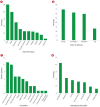Pandemic Influenza A H1N1 in Oman: Epidemiology, Clinical Features, and Outcome of Patients Admitted to Sultan Qaboos University Hospital in 2009
- PMID: 27403242
- PMCID: PMC4927733
- DOI: 10.5001/omj.2016.56
Pandemic Influenza A H1N1 in Oman: Epidemiology, Clinical Features, and Outcome of Patients Admitted to Sultan Qaboos University Hospital in 2009
Abstract
Objectives: Oman experienced the H1N1 pandemic in 2009 that initially started in Mexico and the United States. We present the epidemiology, clinical features, and outcome of cases admitted to Sultan Qaboos University Hospital.
Methods: We retrospectively reviewed all patients admitted with confirmed influenza A H1N1 infection from August to December 2009. The study included adults and pediatric patients. We looked at the clinical and laboratory factors associated with increased length of hospital stay.
Results: There were 68 patients admitted with influenza A H1N1 infection, and their median age was 23 years. The most common symptoms were fever (100%) and cough (79.4%). The most common reason for admission was the severity of illness (69.1%). Lymphopenia was the most common hematological abnormality (41.8%). All patients received treatment with oseltamivir. One patient died secondary to multi-organ failure. On multivariate analysis, severity of illness, use of steroids, anemia, lymphopenia, and abnormal alanine amino transferase levels were associated with increased length of stay.
Conclusions: The H1N1 pandemic in Oman followed the international trends in terms of clinical presentation and laboratory values for patients admitted to the hospital.
Keywords: Epidemics; Influenza A Virus, H1N1 Subtype; Influenza, Human; Oman.
Figures


References
-
- CDC. Outbreak of Swine-Origin Influenza A (H1N1) Virus Infection --- Mexico, March--April 2009 [Internet]. cdc.gov. 2009 [cited 2015 Jul 9]. Available from: http://www.cdc.gov/mmwr/preview/mmwrhtml/mm58d0430a2.htm.
-
- WHO. Swine influenza: Statement by WHO Director-General, Dr Margaret Chan [Internet]. who.int. 2009 [cited 2015 Jul 9]. Available from: http://www.who.int/mediacentre/news/statements/2009/h1n1_20090425/en/.
-
- WHO. World now at the start of 2009 influenza pandemic: Statement to the press by WHO Director-General Dr Margaret Chan [Internet]. who.int. 2009 [cited 2015 July 9]. Available from: http://www.who.int/mediacentre/news/statements/2009/h1n1_pandemic_phase6....
-
- Pandemic WH. (H1N1) 2009 - update 88 [Internet]. who.int. 2010 [cited 2015 July 10]. Available from: http://www.who.int/csr/don/2010_02_19/en/.
-
- Bennett JE, Dolin R, Blaser MJ. Mandell, Douglas, and Bennett’s Principles and Practice of Infectious Diseases. Elsevier Health Sciences; 2014.
LinkOut - more resources
Full Text Sources
Other Literature Sources
